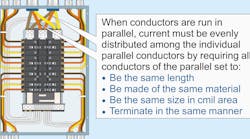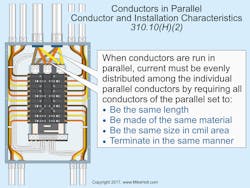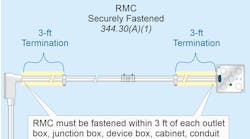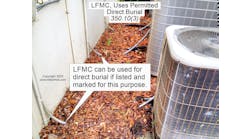All questions and answers are based on the 2017 NEC.
Q. What does the NEC require of conductors in order to use them in locations exposed to direct sunlight?
A. Insulated conductors and cables exposed to the direct rays of the sun must be [Sec. 310.10(D)]:
(1) Listed as sunlight resistant or marked as being sunlight resistant.
SE cable and the conductors contained in the cable are listed as sunlight resistant. However, according to the UL listing standard, the conductors contained in SE cable aren’t required to be marked as sunlight resistant.
Types TW, THW, THW-2, THHW, THWN, and THWN-2 are some of the insulation types that may be marked “Sunlight Resistant” [UL White Book].
(2) Covered with insulating material, such as tape or sleeving materials that are listed as being sunlight resistant or marked as being sunlight resistant.
Q. When conductors are installed in parallel, what does the Code require regarding the conductor and installation characteristics?
A. When circuit conductors are installed in parallel, the conductors must be connected so the current will be evenly distributed between the individual parallel conductors by requiring all circuit conductors within each parallel set to [Sec. 310.10(H)(2)] (see Figure):
(1) Be the same length.
(2) Consist of the same conductor material (copper/aluminum).
(3) Be the same size in circular mil area (minimum 1/0 AWG).
(4) Have the same type of insulation (like THHN).
(5) Terminate using the same method (set screw fitting versus compression fitting).
When installed in raceways, parallel circuit conductors must be grouped together in each raceway. This means each raceway of a parallel set must include a phase A, B, and C, the neutral (if used), and the equipment grounding conductor (if used). If all phase A’s are grouped in one raceway, all phase B’s in another raceway, and all phase C’s in another raceway, the magnetic fields surrounding the conductors won’t be able to cancel each other out, causing inductive heating in violation of Sec. 300.20.
Q. What is the Code-required sizing of equipment grounding conductors (EGCs) for circuits in parallel?
A. The EGCs for circuits in parallel must be sized in accordance with Sec. 250.122(F). Sectioned EGCs smaller than 1/0 AWG are permitted in multiconductor cables, if the combined circular mil area of the sectioned EGC in each cable complies with Sec. 250.122 [310.10(H)(5)].
The minimum 1/0 AWG parallel conductor size rule of Sec. 310.10(H) doesn’t apply to EGCs.
Equipment bonding jumpers and supply‑side bonding jumpers are sized in accordance with Sec. 250.102. The equipment bonding jumper isn’t required to be larger than the largest ungrounded circuit conductors supplying the equipment.
Q. What conductor types does the NEC permit to be used in wet locations?
A. Insulated conductors typically used in wet locations include: Types THHW, THWN, THWN‑2, XHHW, or XHHW‑2. Other conductor insulations used in wet locations are MTW, RHW, RHW-2, and SA [Sec. 310.10(C)].
Refer to Table 310.104 for a complete list of conductors that may be installed in wet locations. See Table 400.4 for the use of flexible cords and flexible cable permitted in wet locations. The letter “W” found on the insulation types listed here indicates that installation is suitable for wet locations.
Holt is the owner of Mike Holt Enterprises, Inc. in Leesburg, Fla. He can be reached at www.mikeholt.com.





